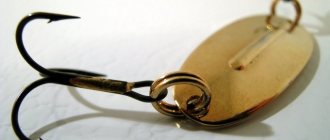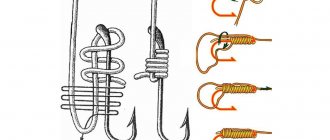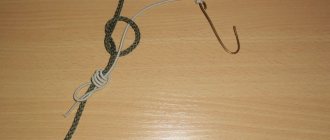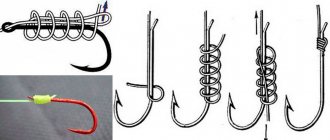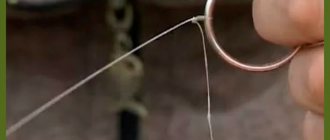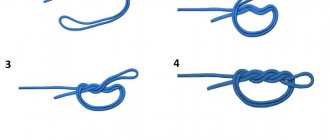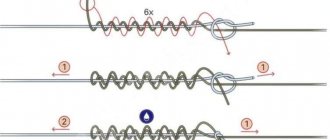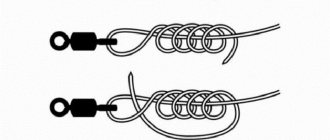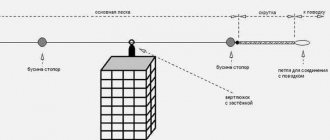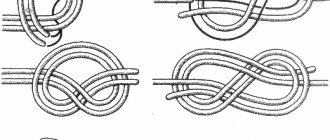While fishing, anglers often encounter line breaks and lost hooks. And if any angler is not insured against cliffs, then only beginners can untie their knots.
The ability to properly tie a hook is necessary for every fisherman. Particular problems arise for inexperienced fishermen when tying hooks with a spatula, since the simplest “loop” knots are not suitable in this case. But if you know the special knots, a hook with a spade can be tied even more securely than with an eye, and this knot will look neater and more compact than on a hook with a hole for fishing line.
Compact knot on hook with shovel
What is the strength of the blade in the design?
Forged hooks with a spatula are popular among fishermen for good reason. This is due to the fact that they are considered more durable and reliable. Usually the knot is less noticeable on them. When a fisherman uses small hooks, it is easier for him to use this design than to pull the line into a small eye.
When tying such hooks, the knot should not have many kinks, as this reduces its strength. However, it cannot be too simple so as not to come untied and slip off. With knots for eyeless hooks, the use of friction is important. The knots should be tied tightly and not allow them to slip.
When tying hooks without an eye, it is especially important to carefully follow certain rules. Usually, complex units are used for this, the technique of which must not only be understood, but also achieved automatically. Only well-mastered nodes will ensure high reliability of the connection.
How to tie a hook with a spatula
There are units whose reliability has been confirmed by many years of practice. To be sure of their strength, you need to tie them carefully, without deviating from the rules. The following are options that are suitable for use with different types of fishing line.
When fishing in cold weather, you need to take into account that braided line sometimes absorbs water and can freeze. Therefore, it is preferable to use it with a tight weave or take nylon fishing line instead. You can use special anti-freeze sprays. Instead, you can use petroleum jelly or a similar material.
Knots for small hook numbers
In this case, using a node, the so-called “python”, is suitable. To do this, do the following:
- Around the forend, make 2 loops in a figure eight, so that the center is on one side and the edges on the other.
- The tip is passed through both loops again and tightened.
In the figure you can see the details of creating a node:
Figure 8 knot
We tie a hook with a spatula to a monofilament fishing line
A universal knot is often used. To use it, you need to do the following:
- The tip of the fishing line is placed vertically along the fore-end from bottom to top with a significant margin.
- Make a small loop on the fold at the bottom.
- The tip of the line is wrapped around the shank of the hook and the tip of the line. In this case, it is enough to make 4-5 revolutions, moving upward. The loops should be parallel to each other and located closely.
- The tip of the fishing line, which should look up, is threaded into the loop located below. The knot is moistened and tightened.
The diagram below shows in detail each stage of tying a knot:
How to tie a spatula hook to fluorocarbon line
For fluorocarbon, a Snell knot is often used. It is known for its high strength. To apply it you need to do the following:
- The fishing line is placed along the shank of the hook with a significant margin. Make a big loop. It should be of such a size that the hook can pass through it freely.
- The tip makes turns, capturing the inside of the loop and the fore-end. The coils start at the top and continue down.
- After the last turn, the tip of the fluor is threaded into the loop.
- The knot must be wetted and then tightened.
This image shows details of the knot tying process. It is used for both hooks with a blade and those with an eye.
Knots for very thin and very thick fishing line
For thin fishing line, you can use a blood knot. It has such an unusual name because it is rumored to have been used on whips to punish sailors hundreds of years ago.
To tie a hook to such a knot, perform the following steps:
- The end of the fishing line is placed along the shank of the hook.
- Make a wide turn around it and the fishing line.
- Perform one more such rotation.
- The running end is passed from top to bottom inside the second loop.
- Tighten the knot.
This option has wide application. It is suitable for hooks with a blade, with an eye, and also for creating multi-hook tackle. Details of how to properly tie a knot can be seen in the diagram.
Bloody Knot
To increase the strength of the bloody knot, you can make not one additional loop, but several. In this case, the tip must be threaded through the inside of each of them.
For thick fishing line, using a “deflection” knot is suitable. It is done this way:
- The tip is folded in half.
- Leaving a loop at the bottom, it is wrapped around the fishing line and fore-end, leaving the loops free. You need to make 5-6 turns.
- The tip is passed inside the turns from top to bottom and threaded into the bottom loop left in advance.
- The knot is tightened.
This node also has a second name: shell node. It is considered one of the most durable. It is considered relatively complex, so you need to be especially careful when tying it. How to tie it correctly can be found in the following photo diagram:
Tying a hook with a spatula - step-by-step video:
Attaching to braid
The best knot for a spatula hook is the so-called step knot. It has high reliability, but is relatively complex. It is done this way:
- The tip of the fishing line is folded in half with a significant margin and placed along the shank of the hook.
- It is wound around the fore-end and one fishing line several times, gradually lowering down.
- Then they continue reeling, but this time wrap around both parts of the fishing line. This is also done several times. It is necessary that there is a loop at the bottom.
- The tip is threaded into it. It is recommended to wet the knot before tightening.
If you need to clarify how to tie it, just look at the following photo:
Cord knot
Pros and cons of fluorocarbon
The main positive quality of the material is its invisibility in water. This is due to the light refractive index of polyvinylidene florida (1.42). The refractive index is as close as possible to that of water (1.33). Monoline and braid have a higher coefficient, which increases the visibility of these materials.
Expert opinion
Alexander Petrovich
participant of the Russian Championship in fishing with a float rod
Fluorocarbonate line is very resistant to abrasion due to its rigidity. It withstands a high degree of direct deformation and is much stronger than monofilament. Curvatures are poorly “remembered” by the polymer, which makes it possible for the material to be straight even after untying the knots. However, this does not make the fishing line tensile strength.
After purchasing fluorocarbon fishing line, a fisherman may be faced with three disadvantages of his choice:
- High price. Fluorocarbon is several times more expensive than other fishing line options. To save money, it is recommended to use it only as a leader material.
- Low tensile strength. This material is almost two times weaker than a similar monofilament line. To maintain the same weight, you need to buy a larger diameter, and this will certainly affect your finances.
- Unstable nodes. For this type of leash, only a few types of knots are used.
Problems with polymer strength are easily solved by selecting fishing line with a large diameter. Such a purchase will cost more, but will save nerves and time in the future.
Due to the characteristics of the substance, fluorocarbon fishing line is almost twice as heavy as its analogues. She quickly sinks in the water. This material is best used as a leash, the length of which does not exceed one meter.
Scope of application:
- Fishing with plastic bait (jerkbait). Due to the tightness of the line, the bait naturally moves at depth, which contributes to a good bite in cool water.
- Drop shot. Ideal for fishing in deep places or near the shore. Amur sleeper, catfish, perch, and pike perch readily respond to such bait.
- Fishing in difficult places. The fishing line is perfect for catching predatory fish in rivers with little clutter.
- Spinnerbait lure. Due to the design features of this bait, the possibility of getting caught on underwater vegetation is completely excluded.
We recommend reading: Types of attaching a swivel to the main fishing line
Are you using fluorocarbon line?
Not really
Secrets and tips
In such nodes it is necessary to perform a large number of turns. They should be parallel and in close contact with each other. Overlaps are not allowed. If the tip of the line remains too large, it needs to be cut off. It is enough to leave no more than 2-4 mm.
Tightening should occur in such a way that their shape is not disturbed. If this does happen, it is better not to leave the knot, but to bandage it. It is recommended to wet it before tightening. It allows you to tighten the knot more tightly and thereby make it stronger. This procedure reduces friction when tightening. In some cases it can seriously damage the fishing line.
In order to use hooks with a spatula, there is no need to study a large number of knots; just learn 3-4, but practice their use until it becomes automatic.
Types of knots for fluorocarbon line
Due to friction, fluorocarbon line assemblies often overheat and become damaged. To avoid this phenomenon, it is best to wet the surface of the fishing line with water. Fluorocarbonate requires a large number of weaves in the loops, with their help the knots are strong and durable.
Carrot (Mahin Knot)
Most often used to attach a leash to braid. It is done in several stages:
- Make a regular knot at the end of the leash, do not tighten it all the way.
- A braid is pulled into the same knot for a length of about 15 mm. Next you need to make 10 revolutions forward and six back along the fishing line. It is best if the turns can be arranged in a checkerboard pattern.
- The resulting fastener is generously wetted with water; for additional reliability, the knot must be tightened tightly. The remaining fluorocarbonate is cut 5-10 mm above the node.
The result should be a very strong knot that is almost impossible to notice in the water.
Albright
Indispensable if there is a significant difference in the diameters of the fishing lines. It makes it easy to connect braided and fluorocarbon line. This is done in a few simple steps:
- Fold the material with a larger diameter (fluorocarbonate) in half, leaving a small loop.
- A second line is pulled into the hole formed. After a short distance, a winding is made around the loop.
- To be reliable, you need to make at least seven revolutions. The end of the thin line is pulled back through the first loop.
- The resulting fastener is tightened tightly, the excess ends are trimmed.
This combination of two materials allows you to make a fairly long leash that will be invisible to fish in the water. The diameter of the fluorocarbon line can be up to three times thicker than the second material.
We recommend reading: Equipment for feeder fishing on currents
Grinner
It is considered a universal fastening method. Also used for tying a swivel to monofilament and fluorocarbon fishing line. To tie this node, you need to perform four steps:
- The end of the line passes into the ring of the swivel. For additional reliability, you need to thread at least 15 cm.
- The released tip is applied back to the fishing line. This creates a small loop. Now you need to press the loop with your finger and turn the end of the line back to the swivel.
- By passing the tip under both sides of the fishing line, make the winding further from the loop. You need at least five turns for reliability
- Tighten the fishing line, trim off any unnecessary residue with a knife or scissors.
Rapala
Knots for fluorocarbon line and hook require more strength, rapala is one of these:
- A loop is tied at a distance of approximately 10 cm from the end of the fishing line. It doesn't need to be tightened.
- The tip of the fluorocarbon is threaded through the ring on the swivel and returned to the loop. The fishing line is pulled through it so that a large and small loop is formed.
- The end of the fishing line is threaded through a large loop, the fastening is tightened and cut.
For any type of knot, you need to select swivels with smooth rings without burrs or roughness. An uneven surface of the ring can damage the fishing line and significantly reduce its service life. Before tightening the knot, be sure to wet the surface of the material with water. This will reduce the negative impact of friction on the fluorocarbon.
If you do not have extensive experience tying fishing knots, it is better to practice on a regular rope. This way you won’t ruin your expensive fishing line due to inexperience.
